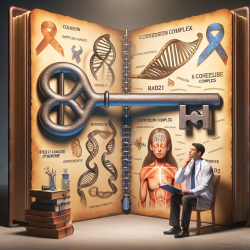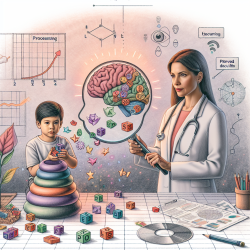Understanding RAD21 and Its Implications for Speech Language Pathologists
The recent study titled "Delineation of phenotypes and genotypes related to cohesin structural protein RAD21" sheds light on the genetic underpinnings of Cornelia de Lange Syndrome (CdLS) and related phenotypes. As a speech language pathologist, understanding these genetic factors can significantly enhance your practice, especially when working with children who may present with communication disorders linked to genetic conditions.
The Role of RAD21 in Genetic Disorders
RAD21 is a crucial component of the cohesin complex, which plays a vital role in chromosome segregation, DNA repair, and gene transcription. Variants in RAD21 have been associated with an attenuated form of CdLS, which is characterized by less pronounced facial morphology, limb anomalies, and cognitive and behavioral challenges compared to variants in other cohesin genes like NIPBL or SMC1A.
Key Findings from the Study
The study analyzed 49 individuals from 33 families with RAD21 alterations, including 24 previously unpublished cases. It highlighted the following key points:
- RAD21 variants often result in a milder CdLS phenotype.
- There is significant interfamilial and intrafamilial variability in phenotypes.
- Protein modeling and molecular dynamics can help determine the pathogenicity of RAD21 variants.
- Careful phenotyping is essential for interpreting the consequences of RAD21 variants.
Implications for Speech Language Pathologists
As practitioners, understanding the genetic basis of disorders can help tailor interventions more effectively. Here are some ways to incorporate these findings into practice:
- Early Identification: Recognize signs of CdLS and related disorders early, especially in children with known RAD21 variants.
- Customized Interventions: Use knowledge of the specific genetic profile to customize therapy plans, focusing on areas like language development and social communication.
- Collaboration with Geneticists: Work closely with geneticists to understand the specific RAD21 variant and its potential impact on communication abilities.
- Family Counseling: Provide families with information about the genetic aspects of their child's condition, helping them understand the variability and potential outcomes.
Encouraging Further Research
While this study provides valuable insights, further research is needed to fully understand the implications of RAD21 variants. Speech language pathologists are encouraged to stay updated with ongoing research and consider participating in studies that explore the intersection of genetics and communication disorders.
To read the original research paper, please follow this link: Delineation of phenotypes and genotypes related to cohesin structural protein RAD21.










